Think Like a Gardener
Consider this Part 2 of our recent blog that dove into creating a strategy that allows your website to grow alongside your business. Now, let’s assume you’ve decided to take the plunge into the world of WebOps. You’re getting ready to abandon the old school set-it-and-forget it approach to web strategy, and you’re embracing the benefits of WebOps and are ready to grow a great WebOps strategy. But how?
When thinking of your WebOps program, it can be helpful (or at least somewhat more interesting) to liken it to growing a tree. There are a number of things you need to grow a healthy, strong, and vibrant tree, just as there are a number of things you’ll need in order to grow your WebOps strategies. (And if you’re actually interested in how to grow a real tree – here you go) In gardening, it can be as simple as having the right combination – soil, seeds, water, sun, and care. So, let’s take a look at WebOps in the same way.
The Soil – Building Your Team
When planting seeds, the first thing you want to find is great soil. This can make the difference between a healthy, fruitful plant, and one that struggles constantly to grow and germinate. When planting your “WebOps Tree”, the soil for all the great ideas, iterations, and evolution is your team.
By bringing together people from the different web disciplines, and eliminating the barriers that typically happen between departments, the WebOps approach expands the ability to collaborate and innovate. Instead of just a single person (or siloed department) having to “think outside the box” in order to bring in new ideas, WebOps allows teams to take advantage of multiple perspectives and varied experiences. Much like the saying “the whole is more than the sum of its parts”.
A well-constructed WebOps team allows organizations to take advantage of the collective strength of each individual, focusing their wide scope of experience on a single, overarching goal. In this way, much like the soil you plant your seeds, the team provides the foundation for future growth.
The Seeds – Setting the Goals
What do you want your tree to be? Will it have a lot of fruit? Or will it be tall and strong to support children’s swings? Will it have dense, wide foliage to provide shade? Or will it eventually be used to make quality building products? Knowing what you want before you pick your seeds is a pretty important step. And defining what you want the results to be (ie. a healthy tree) is with seeds, and is really no different than creating a strategy with objectives for any other business need.
In order to grow a great WebOps strategy, time and care needs to be spent identifying what you want before you start the process. It’s important to know what and how you’re going to measure success of the process, and how you’re going to edit and redirect your efforts when positive failure points hit.
In this way, an organization’s goals and vision become the seeds for the WebOps plant. With a clear overarching vision for the future, you can plant the ideas that will grow toward the potential you want. Your goals provide direction – cues as to when to prune, when to water, when to feed, and when to harvest. By having an idea of these prior to planting, you’re able to set the proper schedules and plans for the future. Do you get the sense everything is coming together with the proper steps and plan?
Water – Your Scheduled Plan
How you manage and schedule the process can make a tremendous difference in how well your plant grows. In particular, setting a schedule to ensure that your plant receives care and watering can be a major difference maker. Much as a plant without water can wilt before reaching its potential, your WebOps strategy can rot on the vine if it isn’t planned, scheduled, and managed.
WebOps relies on making small, incremental changes over and over again in order to evolve the web presence. For this to be successful, those iterations need to be planned accordingly. Without a plan and schedule, it can be possible to pursue changes that have no strategic value. Worse still, the lack of schedule can cause momentum to stall if there is too much time taken between iterations, or if nobody is held accountable for the execution.
By watering your WebOps tree with a consistent, constant, and carefully thought out plan, you are able to measure, analyze, and track successes and positive failures. Without this kind of care, the likelihood of success is threatened.
Sunlight – Constant Iterations
In gardening, sunlight provides the energy necessary for specific chemical reactions and growth. Just like photosynthesis gives plants and trees the nourishment to sprout and spread, iterations provide the building blocks for your WebOps strategy. 
Iterations are the key point in the WebOps process. The focus on small iterative changes – rather than trying to pull off massive changes all at once – is an important distinction between WebOps and traditional Web development.
Every iteration, all new datasets, and each determination of success or positive failure feeds the growth of your WebOps tree. Whether your strategy moves onto the next iteration or edits the last one, every time you iterate, your tree is growing on a stronger branch. Just as the sun nourishes the soul of your tree, iterations feed the growth of your WebOps plan.
Pruning – Your MVPS
While maintaining a constant schedule provides the water for your tree, working towards specific website MVPs (Minimal Viable Product) provides the necessary care and maintenance. By setting key milestones along the path, organizations are better able to track progress and keep their WebOps strategies on track.

MVPs function not only as milestones, but also guides. If specific iterative paths end up going awry, pulling attention back to the MVP helps to maintain focus and direction. Pruning tactics and strategies that lead away from your guides helps to ensure that your WebOps plan continues to grow in the direction envisioned from the start.
Each time you “prune” your strategy on the way towards your MVP, you help your tree grow in the direction you want. Every time you cut a bad branch, you make room for healthy ones to grow.
A Healthy Tree – Your WebOps Program
Evolving your web properties through WebOps is a process – one that requires care, attention, and clear direction. Like raising a tree from acorn to arbor you’ll need good soil, a great seed, constant watering, nourishing sunlight, and careful pruning along the way.
While the process takes time, the rewards can be amazing. And with less than a green thumb, any team can reap the benefits and rewards of a well-grown WebOps tree.







